Soil Moisture Conservation through Crop Diversification and Related Ecosystem Services in a Blown-Sand Area with High Drought Hazard
Abstract
1. Introduction
- It increases incomes for small farms;
- Helps withstand fluctuations in commodity prices;
- Provides resilience to extreme weather conditions (surplus rainfall or drought);
- Reduces the costs of production;
- Provides more varied and healthy foods, both for humans and livestock;
- Diminishes pest hazards and weed growth;
- Enhances beneficial pollinator populations;
- Improves soil quality in the long term;
- Broadens employment.
- Enhancing soil moisture preservation by preventing or hindering desiccation. This would require regular irrigation to allow crusting, but under the climatic conditions of the study area, it cannot be implemented in the long run.
- Ensuring better protection of the surface by vegetation cover, reducing wind energy by forest belts [27], or providing a contiguous cover by denser cropping. However, this is jeopardized by the water scarcity almost permanently present throughout the growing season.
- Mulching could increase the soil’s organic matter content, and thus, soil aggregation. Organic matter in itself contributes to soil moisture conservation and balances soil temperature and pH. However, for the decomposition of organic matter via microbial activity [28], the soil moisture content available in the long term is usually not adequate. The aggregate stability of the wind-blown sand is also low because of the minimum clay content (the latter is only higher in buried paleosols, formed in wetter spells of landscape history).
2. Study Area
3. Results and Discussion
4. Methods
4.1. Estimation of Climatic Water Deficit
4.2. Crop Treatments
4.3. Crop Diversification Options
4.4. Monitoring Soil Properties and Soil Moisture
4.5. Wind Erosion Measurements
4.6. Emission of Greenhouse Gases
5. Conclusions
- Higher organic matter content and cation exchange capacity point to increased soil fertility.
- More complete soil cover and reduced cultivation diminish desiccation hazards and ensure the necessary moisture in the topsoil for cover crops too.
- The condition of the soil surface was the same in all plots; the differences in sediment transport by the wind were exclusively caused by diversification.
- The particle size of the entrained dust fraction stabilized at a height of 400 cm, where the proportion of the 0.7–8 μm fraction (fine organic matter) increased. During periods of drought, dust storms significantly reduced soil fertility.
- Complete desiccation of the soil surface often occurred during the experimental period. In such cases, there was no solution to protect the soil, so diversification did not help either. At times of minimal wetting, crop diversity and the use of cover crops in broad alleys can reduce wind erosion.
Author Contributions
Funding
Data Availability Statement
Acknowledgments
Conflicts of Interest
References
- Bàrberi, P.; Moonen, A.C. (Eds.) Reconciling Agricultural Production with Biodiversity Conservation; Burleigh-Dodds Science Publishing: Cambridge, UK, 2020. [Google Scholar] [CrossRef]
- Griffiths, B.S.; Römbke, J.; Schmelz, R.M.; Scheffczyk, A.; Faber, J.H.; Bloem, J.; Pérès, G.; Cluzeau, D.; Chabbi, A.; Suhadolc, M.; et al. Selecting Cost Effective and Policy-Relevant Biological Indicators for European Monitoring of Soil Biodiversity and Ecosystem Function. Ecol. Indic. 2016, 69, 213–223. [Google Scholar] [CrossRef]
- Mirzabaev, A.; Stringer, L.C.; Benjaminsen, T.A.; Gonzalez, P.; Harris, R.; Jafari, M.; Stevens, N.; Tirado, C.M.; Zakieldeen, S. Cross-Chapter Paper 3: Deserts, Semiarid Areas and Desertification. In Climate Change 2022: Impacts, Adaptation and Vulnerability; Contribution of Working Group II to the Sixth Assessment Report of the Intergovernmental Panel on Climate Change; Cambridge University Press: Cambridge, UK; New York, NY, USA, 2022; pp. 2195–2231. [Google Scholar] [CrossRef]
- Kertész, Á.; Mika, J. Aridification—Climate change in South-Eastern Europe. Phys. Chem. Earth Part A Solid Earth Geod. 1999, 24, 913–920. [Google Scholar] [CrossRef]
- FAO. Action against Desertification. Overview: Desertification and Land Degradation. 2023. Available online: https://www.fao.org/in-action/action-against-desertification/overview/desertification-and-land-degradation/en/ (accessed on 11 May 2023).
- Adeel, Z.; Safriel, U.; Niemeijer, D.; White, R.; de Kalbermatter, G.; Glantz, M. Ecosystems and Human Well-Being: Desertification Synthesis: A Report of the Millennium Ecosystem Assessment; World Resources Institute: Washington, DC, USA, 2005. [Google Scholar]
- Liu, Y.; Xue, Y. Expansion of the Sahara Desert and shrinking of frozen land of the Arctic. Sci. Rep. 2020, 10, 4109. [Google Scholar] [CrossRef] [PubMed]
- Fehér, Z.Z.; Rakonczai, J. Analysing the sensitivity of Hungarian landscapes based on climate change induced shallow groundwater fluctuation. Hung. Geogr. Bull. 2019, 68, 355–372. [Google Scholar] [CrossRef]
- EU Commission. Farm to Fork Strategy. For a Fair, Healthy and Environmentally-Friendly Food System. European Union. 2020. Available online: https://food.ec.europa.eu/system/files/2020-05/f2f_action-plan_2020_strategy-info_en.pdf (accessed on 11 May 2023).
- TEEB. The Economics of Ecosystems and Biodiversity: Mainstreaming the Economics of Nature: A Synthesis of the Approach, Conclusions and Recommendations of Teeb; UNEP TEEB: Geneva, Switzerland, 2010; Available online: https://teebweb.org/publications/teeb-for/synthesis/ (accessed on 11 May 2023).
- Lin, B.B. Resilience in Agriculture through Crop Diversification: Adaptive Management for Environmental Change. BioScience 2011, 61, 183–193. [Google Scholar] [CrossRef]
- Walia, M.K. Crop Diversification; University of Nevada: Reno, NV, USA, 2020; Available online: https://extension.unr.edu/publication.aspx?PubID=3816 (accessed on 15 April 2023).
- Borhidi, A. A növények társadalma (Society of plants). In Gaia zöld ruhája (Gaia’s Green Clothes); Akadémiai Kiadó: Budapest, Hungary, 2003; pp. 287–308. Available online: https://adoc.pub/borhidi-attila-a-nvenyek-tarsadalma.html (accessed on 15 April 2023). (In Hungarian)
- Dudley, S.A.; Murphy, G.P.; File, A.L. Kin recognition and competition in plants. Funct. Ecol. 2013, 27, 898–906. [Google Scholar] [CrossRef]
- Wezel, A.; Casagrande, M.; Celette, F.; Vian, J.-F.; Ferrer, A.; Peigné, J. Agroecological Practices for Sustainable Agriculture. A Review. Agron. Sustain. Dev. 2014, 34, 1–20. [Google Scholar] [CrossRef]
- Beillouin, D.; Ben-Ari, T.; Malezieux, E.; Seufert, V.; Makowski, D. Positive but Variable Effects of Crop Diversification on Biodiversity and Ecosystem Services. Glob. Chang. Biol. 2021, 27, 4697–4710. [Google Scholar] [CrossRef] [PubMed]
- Zabala, J.A.; Martínez-García, V.; Martínez-Paz, J.M.; López-Becerra, E.I.; Nasso, M.; Díaz-Pereira, E.; Sánchez-Navarro, V.; Álvaro-Fuentes, J.; González-Rosado, M.; Farina, R.; et al. Crop diversification practices in Europe: An economic cross-case study comparison. Sustain. Sci. 2023, 18, 2691–2706. [Google Scholar] [CrossRef]
- Tamburini, G.; Bommarco, R.; Wanger, T.C.; Kremen, C.; van der Heijden, M.G.A.; Liebman, M.; Hallin, S. Agricultural Diversification Promotes Multiple Ecosystem Services without Compromising Yield. Sci. Adv. 2020, 6, eaba1715. [Google Scholar] [CrossRef]
- Bethwell, C.; Burkhard, B.; Daedlow, K.; Sattler, C.; Reckling, M.; Zander, P. Towards an enhanced indication of provisioning ecosystem services in agro-ecosystems. Environ. Monit. Assess. 2021, 193 (Suppl. S1), 269. [Google Scholar] [CrossRef]
- Di Bene, C.; Gómez-López, M.D.; Francaviglia, R.; Farina, R.; Blasi, E.; Martínez-Granados, D.; Calatrava, J. Barriers and Opportunities for Sustainable Farming Practices and Crop Diversification Strategies in Mediterranean Cereal-Based Systems. Front. Environ. Sci. 2022, 10, 861225. [Google Scholar] [CrossRef]
- Várallyay, G. Magyarország talajainak vízraktározó képessége (Water storage capacity of soils in Hungary). Agrokem. Talajt. 2005, 54, 5–24. (In Hungarian) [Google Scholar] [CrossRef]
- Kocsis, M.; Dunai, A.; Farsang, A.; Makó, A. Magyarország kistájainak talajspecifikus aszályérzékenysége a szántóföldi növények termésreakciói alapján (Soil-specific drought sensitivity of subregions of Hungary based on yield reactions of arable crops). Földrajzi Közlemények 2018, 142, 89–101. (In Hungarian) [Google Scholar]
- Kis, A.; Pongrácz, R.; Bartholy, J.; Gocic, M.; Milanovic, M.; Trajkovic, S. Multi-scenario and multi-model ensemble of regional climate change projections for the plain areas of the Pannonian Basin. Időjárás 2020, 124, 157–190. [Google Scholar] [CrossRef]
- Farsang, A.; Bartus, M.; Négyesi, G.; Barta, K.; Szatmári, J. Estimation of nutrient movement caused by wind erosion on chernozems based on wind channel experiments. Geophys. Res. Abstr. 2012, 14, EGU2012-13798. [Google Scholar]
- Négyesi, G.; Lóki, J.; Buró, B.; Bertalan-Balázs, B.; Pásztor, L. Wind erosion researches in Hungary—Past, present and future possibilities. Hung. Geogr. Bull. 2019, 68, 223–240. [Google Scholar] [CrossRef]
- Yang, C.-H.; Geng, Y.-X.; Xing, Z.-F.; Coulter, J.A.; Chai, Q. The Effects of Wind Erosion Depending on Cropping System and Tillage Method in a Semi-Arid Region. Agronomy 2020, 10, 732. [Google Scholar] [CrossRef]
- Négyesi, G. Mezővédő fásítások tér- és időbeli változásának vizsgálata a Nyírségben—A szélerózió szemszögéből (Spatial and temporal changes in the distribution of shelter belts in the Nyírség—From the aspect of wind erosion). Tájökológiai Lapok 2018, 16, 113–128. (In Hungarian) [Google Scholar] [CrossRef]
- Swaminathan, C.; Nivethadevi, P.; Pandian, K. Soil Organic Matter Decomposition—Roles, Factors and Mechanisms. In Latest Trends in Soil Sciences; Singh Porte, S., Ed.; Integrated Publications: New Delhi, India, 2021; Volume 1, pp. 61–91. [Google Scholar] [CrossRef]
- Burezq, H. Combating wind erosion through soil stabilization under simulated wind flow condition—Case of Kuwait. Int. Soil Water Conserv. Res. 2020, 8, 154–163. [Google Scholar] [CrossRef]
- Niziolomski, J.C.; Simmons, R.W.; Rickson, R.J.; Hann, M.J. Efficacy of mulch and tillage options to reduce runoff and soil loss from asparagus interrows. Catena 2020, 191, 104557. [Google Scholar] [CrossRef]
- Biró, M.; Révész, A.; Molnár, Z.; Horváth, F.; Czúcz, B. Regional habitat pattern of the Danube-Tisza Interfluve in Hungary II The sand, the steppe and the riverine vegetation, degraded and regenerating habitats, regional habitat destruction. Acta Bot. Hung. 2008, 50, 19–60. [Google Scholar] [CrossRef]
- Kocsis, K. (Ed.) Natural Landscapes. In National Atlas of Hungary. The Natural Environment; Geographical Institute, Research Centre for Astronomy and Earth Sciences, Hungarian Academy of Sciences: Budapest, Hungary, 2019; pp. 126–127. [Google Scholar]
- Farkas, J.Z.; Hoyk, E.; Rakonczai, J. Geographical analysis of climate vulnerability at a regional scale: The case of the Southern Great Plain in Hungary. Hung. Geogr. Bull. 2017, 66, 129–144. [Google Scholar] [CrossRef]
- Farkas, J.Z.; Kovács, A.D. Nature conservation versus agriculture in the light of socio-economic changes over the last half-century–Case study from a Hungarian national park. Land Use Policy 2021, 101, 105131. [Google Scholar] [CrossRef]
- Cserni, I.; Pető, J.; Hüvely, A. A Duna-Tisza közi homokhátság múltbeli, jelenlegi és jövőbeli kutatási eredményei és lehetőségei (Research and perspectives of the Danube-Tisza Sand Region in the past, present and future). Economica 2015, 4, 12–20. (In Hungarian) [Google Scholar] [CrossRef]
- Szabó, A.; Gribovszki, Z.; Kalicz, P.; Szolgay, J.; Bolla, B. The soil moisture regime and groundwater recharge in aged forests in the Sand Ridge region of Hungary after a decline in the groundwater level: An experimental case study. J. Hydrol. Hydromech. 2022, 70, 308–320. [Google Scholar] [CrossRef]
- Trásy-Havril, T.; Szkolnikovics-Simon, S.; Mádl-Szőnyi, J. How Complex Groundwater Flow Systems Respond to Climate Change Induced Recharge Reduction? Water 2022, 14, 3026. [Google Scholar] [CrossRef]
- Pappa, V.A.; Rees, R.M.; Walker, R.L.; Baddeley, J.A.; Watson, C.A. Nitrous oxide emissions and nitrate leaching in an arable rotation resulting from the presence of an intercrop. Agric. Ecosyst. Environ. 2011, 141, 153–161. [Google Scholar] [CrossRef]
- Oertel, C.; Matschullat, J.; Zurba, K.; Zimmermann, F.; Erasmi, S. Greenhouse gas emissions from soils—A review. Geochemistry 2016, 76, 327–352. [Google Scholar] [CrossRef]
- Senbayram, M.; Wenthe, C.; Lingner, A.; Isselstein, J.; Steinmann, H.; Kaya, C.; Köbke, S. Legume-based mixed intercropping systems may lower agricultural born N2O emissions. Energy Sustain. Soc. 2015, 6, 2. [Google Scholar] [CrossRef]
- Qiu, Q.; Wu, L.; Ouyang, Z.; Li, B.; Xu, Y.; Wu, S.; Gregorich, E.G. Effects of plant-derived dissolved organic matter (DOM) on soil CO2 and N2O emissions and soil carbon and nitrogen sequestrations. Appl. Soil Ecol. 2015, 96, 122–130. [Google Scholar] [CrossRef]
- Basche, A.D.; Miguez, F.E.; Kaspar, T.C.; Castellano, M.J. Do cover crops increase or decrease nitrous oxide emissions? A meta-analysis. J. Soil Water Conserv. 2014, 69, 471–482. [Google Scholar] [CrossRef]
- Zafiriou, P.; Mamolos, A.P.; Menexes, G.C.; Siomos, A.S.; Tsatsarelis, C.A.; Kalburtji, K.L. Analysis of energy flow and greenhouse gas emissions in organic, integrated and conventional cultivation of white asparagus by PCA and HCA: Cases in Greece. J. Clean. Prod. 2012, 29, 20–27. [Google Scholar] [CrossRef]
- Russo, G.; Caruso, G.; Villari, G.; Borrelli, C. Effects of crop method and harvest seasons on yield and quality of green asparagus under tunnel in southern Italy. Adv. Hortic. Sci. 2012, 26, 51–58. [Google Scholar] [CrossRef]
- Álvaro-Fuentes, J.; Lóczy, D.; Thiele-Bruhn, S.; Zornoza, R. (Eds.) Handbook of Plant and Soil Analysis for Agricultural Systems; Crai Ediciones, Universidad Politécnica de Cartagena: Cartagena, Spain, 2019. [Google Scholar]
- Palmer, W.C. Meteorological Drought; U.S. Research Paper 45, Indicator codes CLIM 029, LSI 007; US Weather Bureau: Washington, DC, USA, 1965; 58p. Available online: https://www.ncdc.noaa.gov/temp-and-precip/drought/docs/palmer.pdf (accessed on 10 March 2023).
- Ács, F.; Breuer, H.; Szász, G. Estimation of actual evapotranspiration and soil water content in the growing season. Agrokem. Talajt. 2007, 56, 217–236. [Google Scholar] [CrossRef]
- Lakatos, M.; Weidinger, T.; Hoffmann, L.; Bihari, Z.; Horváth, Á. Computation of daily Penman-Monteith reference evapotranspiration in the Carpathian Region and comparison with Thornthwaite estimates. Adv. Sci. Res. 2020, 16, 251–259. [Google Scholar] [CrossRef]
- Szalai, V.; Weidinger, T.; Dezső, J. Párolgásbecslések hazai spárga és szőlőültetvényeken (Estimation of evaporation in asparagus and grapevine plantations of Hungary). Légkör 2021, 64, 5–10. (In Hungarian) [Google Scholar]
- Erdős, Z. A Genotípus És Tápanyagellátási Forma Hatékonyságának Vizsgálata Halványított Spárgában (Investigation of the Efficiency and Genotype and Nutrient Recharge in White Asparagus). Ph.D. Thesis, Kerpely Kálmán Doctoral School, University of Debrecen, Debrecen, Hungary, 2019; 201p. (In Hungarian). [Google Scholar]
- Campi, P.; Mastrorilli, M.; Stellacci, A.M.; Modugno, F.; Palumbo, A.D. Increasing the effective use of water in green asparagus through deficit irrigation strategies. Agric. Water Manag. 2019, 217, 119–130. [Google Scholar] [CrossRef]
- Fehér, B. A Spárgaültetvények Tápanyagellátása (Nutrient Supply of Asparagus Plantations). Kertészet Szőlészet. 2011. Available online: https://magyarmezogazdasag.hu/2011/04/27/spargaultetvenyek-tapanyagellatasa (accessed on 13 June 2023). (In Hungarian).
- Kalomira, E. Asparagus diseases. Eur. J. Plant Sci. Biotechnol. 2007, 1, 76–83. Available online: http://www.globalsciencebooks.info/Online/GSBOnline/images/0706/EJPSB_1(1)/EJPSB_1(1)76-83o.pdf (accessed on 11 June 2023).
- Drost, D.; Wilson, D. Monitoring root length density and root biomass in asparagus (Asparagus officinalis) with soil cores. N. Z. J. Crop Hortic. Sci. 2003, 31, 125–137. [Google Scholar] [CrossRef][Green Version]
- Huber, S.; Prokop, G.; Arrouays, D.; Banko, G.; Bispo, A.; Jones, R.J.A.; Kibblewhite, M.G.; Lexer, W.; Möller, A.; Rickson, R.J.; et al. (Eds.) Environmental Assessment of Soil for Monitoring: Volume I Indicators & Criteria; EUR 23490 EN/1; Office for the Official Publications of fthe European Communities: Luxembourg, 2008; 339p. [Google Scholar]
- Bittelli, M. Measuring Soil Water Content: A Review. Horttechnology 2011, 21, 293–300. [Google Scholar] [CrossRef]
- Davood, N.-K.; Shorafa, M.; Heidari, A. Estimating Soil Water Content from Permittivity for Different Mineralogies and Bulk Densities. Soil Sci. Soc. Am. J. 2012, 76, 1149–1158. [Google Scholar] [CrossRef]
- Bartus, M.; Barta, K.; Szatmári, J.; Farsang, A. Modeling wind erosion hazard control efficiency with an emphasis on shelterbelt system and plotsize planning. Z. Geomorphol. 2017, 61, 123–133. [Google Scholar] [CrossRef]
- Bartus, M.; Barta, K.; Szatmári, J.; Farsang, A. Csongrád megye talajainak szélcsatorna kísérletekre alapozott szélerózió veszélyeztetettség becslése (Windtunnel experiments for wind erosion risk estimation of soils in Csongrád County). Agrokem. Talajt. 2019, 68, 225–242. (In Hungarian) [Google Scholar] [CrossRef][Green Version]
- Díaz Pereira, E.; Martinez-Mena, M.; de Vente, J.; Almagro Bonmatí, M.; Boix-Fayos, C. Total Carbon (organic and inorganic carbon) and nitrogen. In Handbook of Plant and Soil Analysis for Agricultural Systems; Álvaro-Fuentes, J., Lóczy, D., Thiele-Bruhn, S., Zornoza, R., Eds.; Crai Ediciones, Universidad Politécnica de Cartagena: Cartagena, Spain, 2019; pp. 157–160. [Google Scholar]
- Regina, K.; Hüppi, R. Soil Greenhouse gas emissions. In Handbook of Plant and Soil Analysis for Agricultural Systems; Álvaro-Fuentes, J., Lóczy, D., Thiele-Bruhn, S., Zornoza, R., Eds.; Crai Ediciones, Universidad Politécnica de Cartagena: Cartagena, Spain, 2019; pp. 290–293. [Google Scholar]
- Hüppi, R.; Horváth, L.; Dezső, J.; Puhl-Rezsek, M.; Six, J. Soil Nitrous Oxide Emission and Methane Exchange from Diversified Cropping Systems in Pannonian Climate. Front. Environ. Sci. 2022, 10, 277. [Google Scholar] [CrossRef]
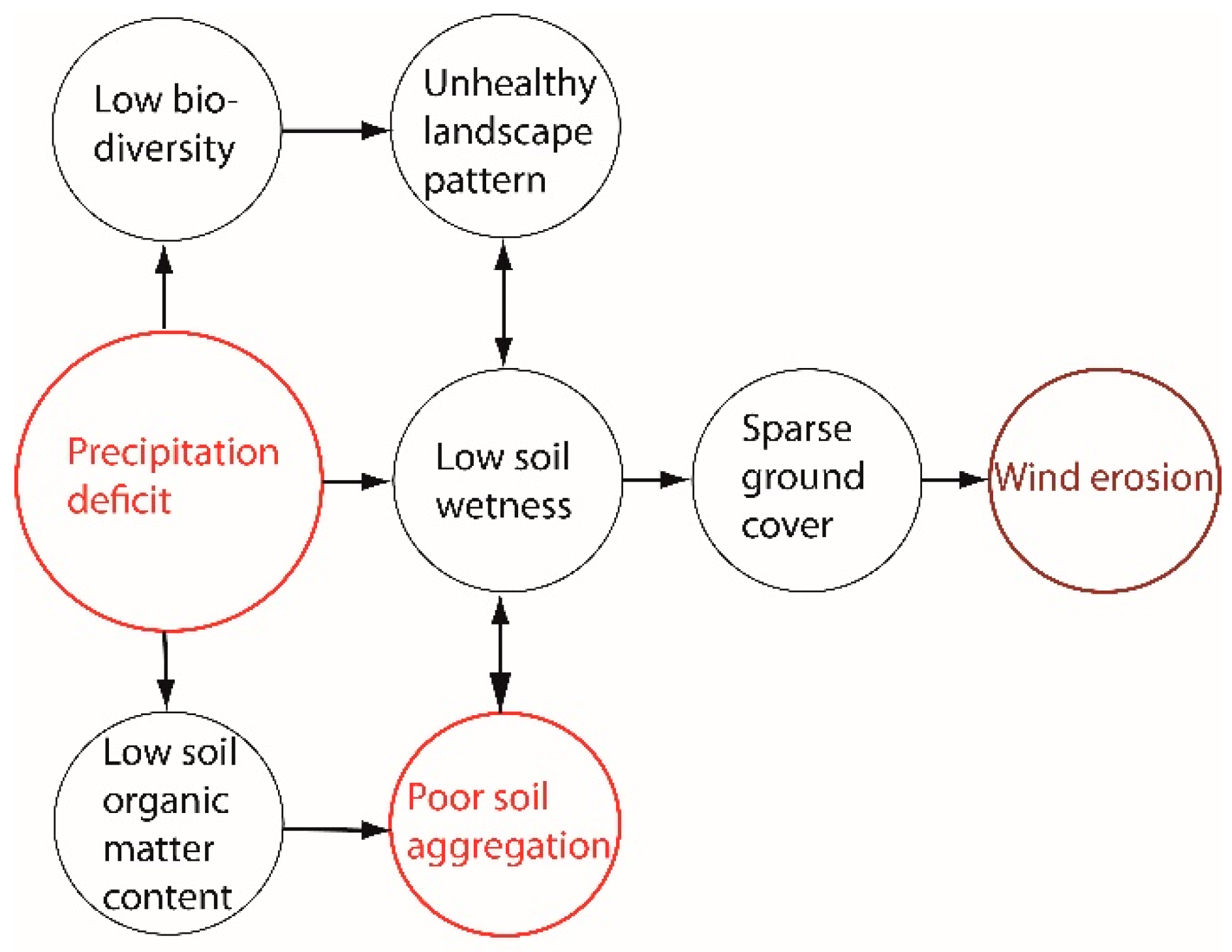
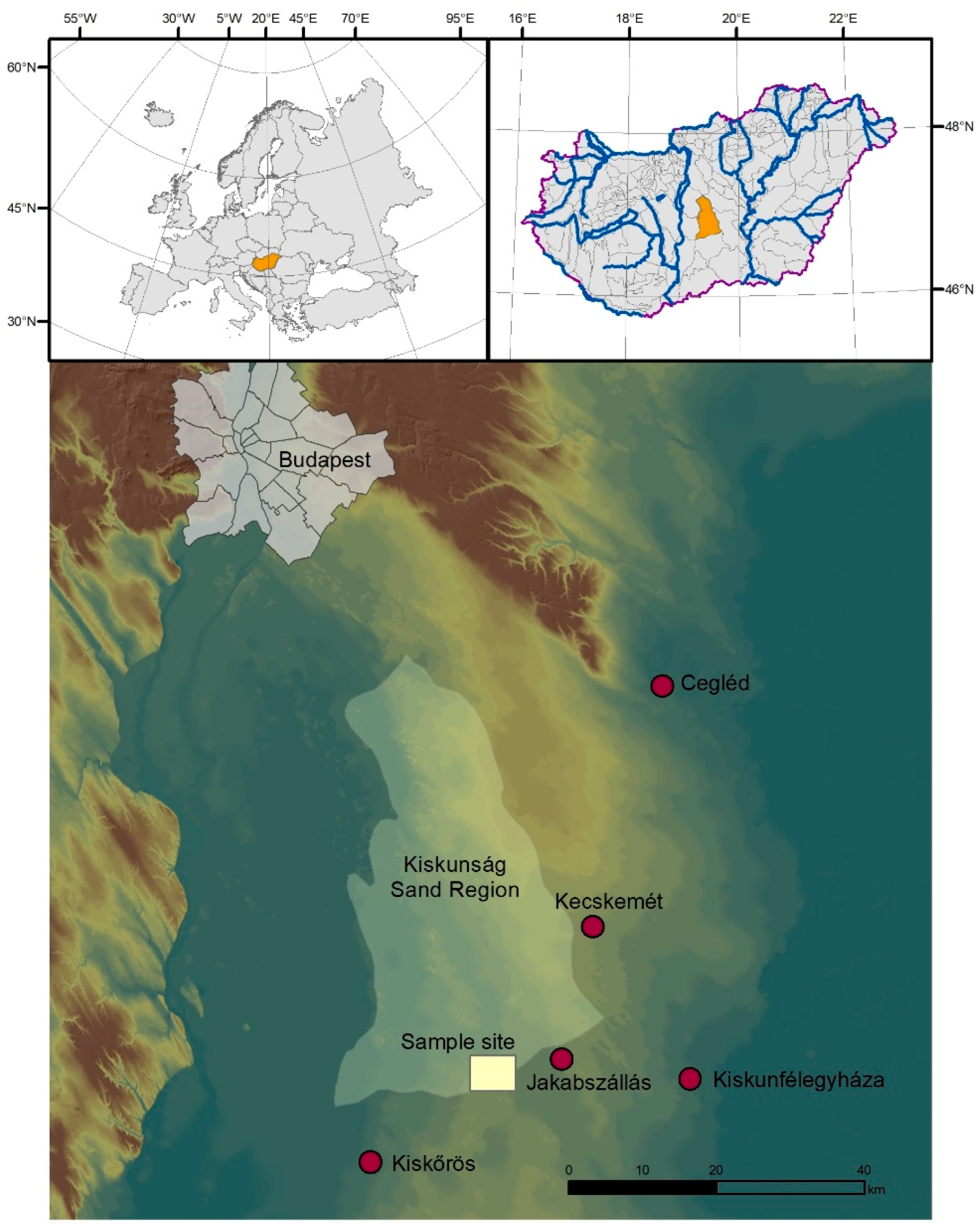


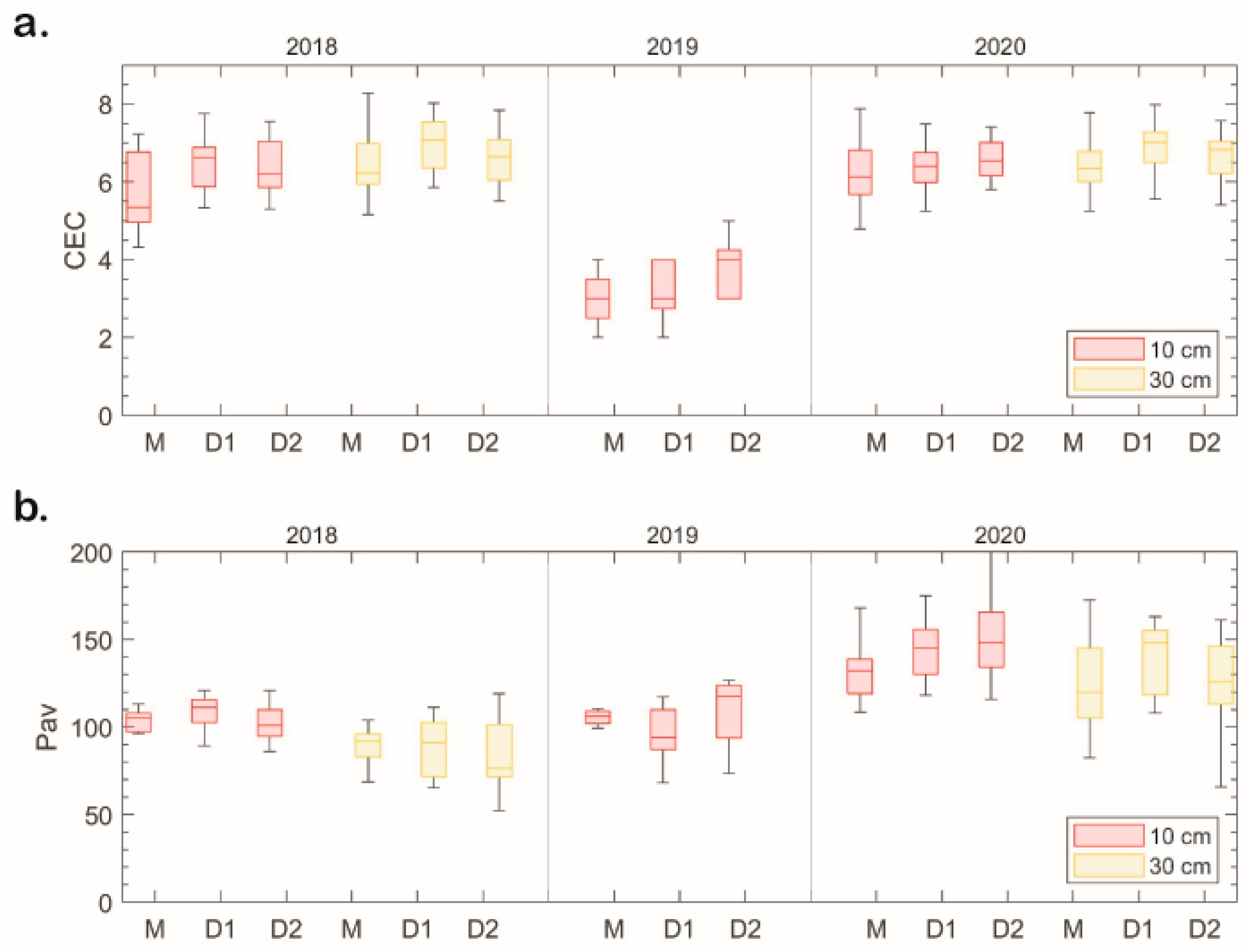


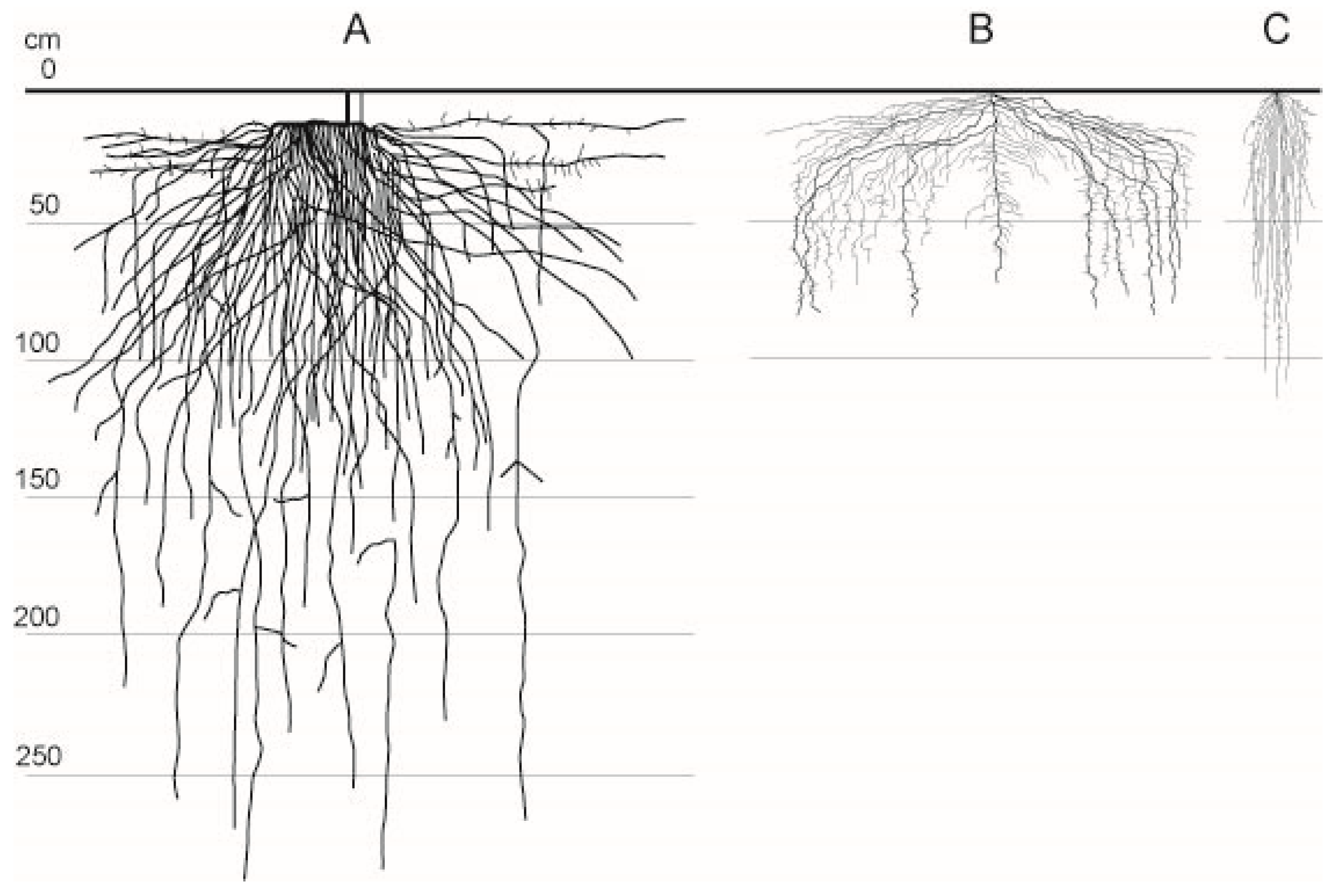
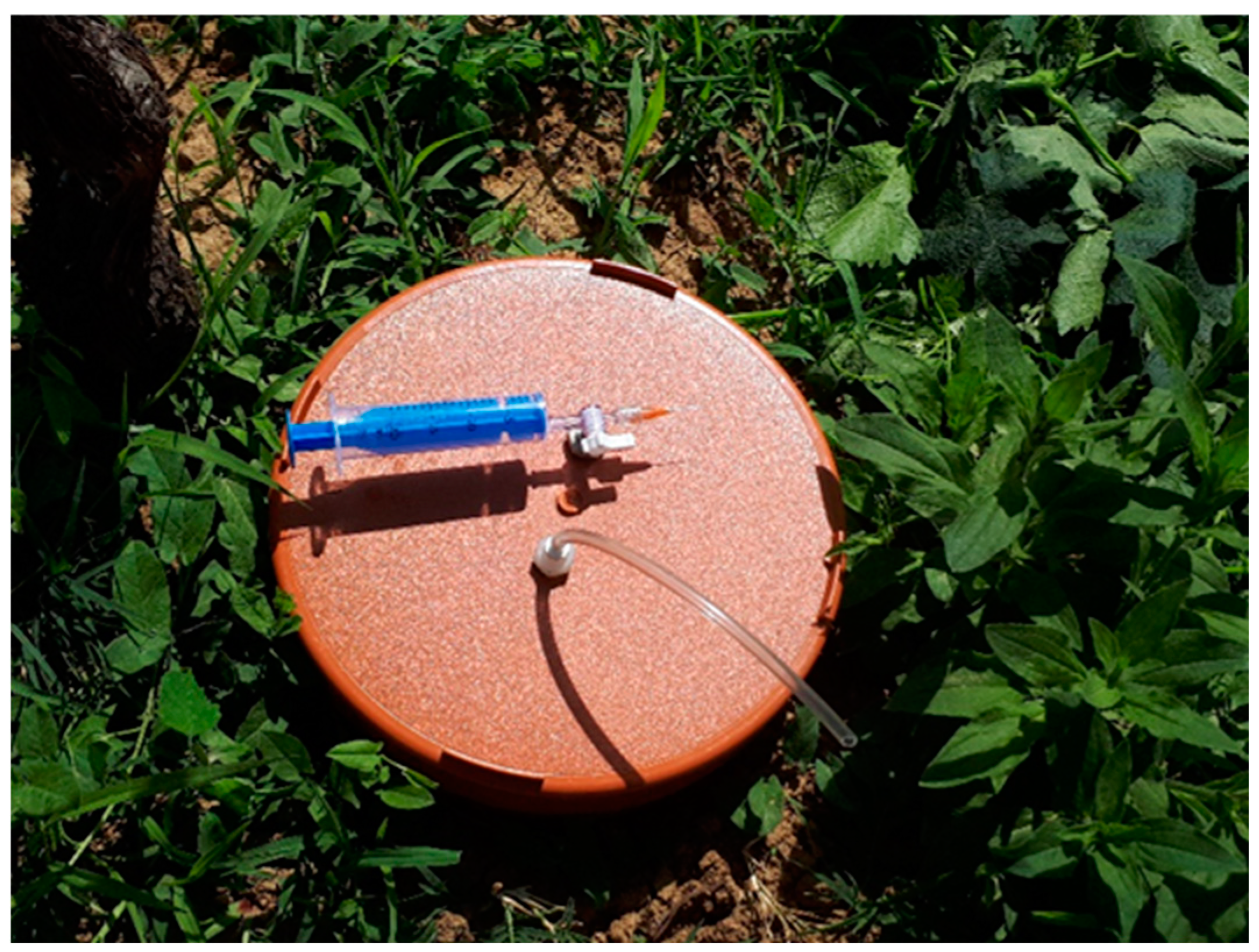
Disclaimer/Publisher’s Note: The statements, opinions and data contained in all publications are solely those of the individual author(s) and contributor(s) and not of MDPI and/or the editor(s). MDPI and/or the editor(s) disclaim responsibility for any injury to people or property resulting from any ideas, methods, instructions or products referred to in the content. |
© 2024 by the authors. Licensee MDPI, Basel, Switzerland. This article is an open access article distributed under the terms and conditions of the Creative Commons Attribution (CC BY) license (https://creativecommons.org/licenses/by/4.0/).
Share and Cite
Lóczy, D.; Dezső, J.; Weidinger, T.; Horváth, L.; Pirkhoffer, E.; Czigány, S. Soil Moisture Conservation through Crop Diversification and Related Ecosystem Services in a Blown-Sand Area with High Drought Hazard. Plants 2024, 13, 494. https://doi.org/10.3390/plants13040494
Lóczy D, Dezső J, Weidinger T, Horváth L, Pirkhoffer E, Czigány S. Soil Moisture Conservation through Crop Diversification and Related Ecosystem Services in a Blown-Sand Area with High Drought Hazard. Plants. 2024; 13(4):494. https://doi.org/10.3390/plants13040494
Chicago/Turabian StyleLóczy, Dénes, József Dezső, Tamás Weidinger, László Horváth, Ervin Pirkhoffer, and Szabolcs Czigány. 2024. "Soil Moisture Conservation through Crop Diversification and Related Ecosystem Services in a Blown-Sand Area with High Drought Hazard" Plants 13, no. 4: 494. https://doi.org/10.3390/plants13040494
APA StyleLóczy, D., Dezső, J., Weidinger, T., Horváth, L., Pirkhoffer, E., & Czigány, S. (2024). Soil Moisture Conservation through Crop Diversification and Related Ecosystem Services in a Blown-Sand Area with High Drought Hazard. Plants, 13(4), 494. https://doi.org/10.3390/plants13040494







